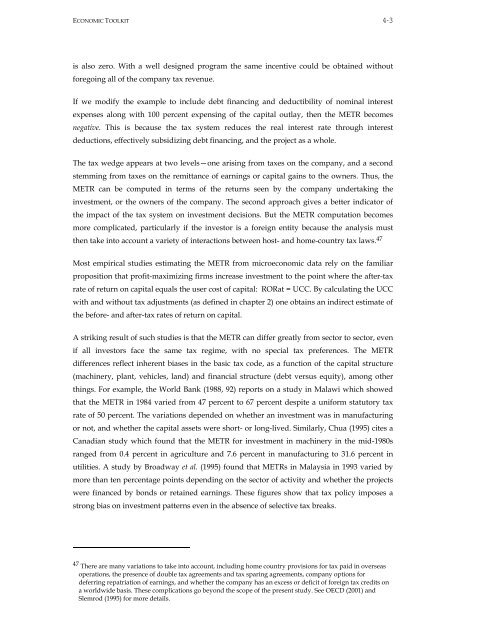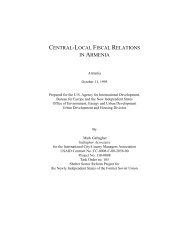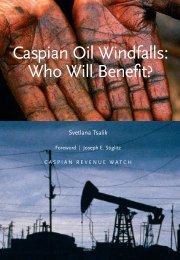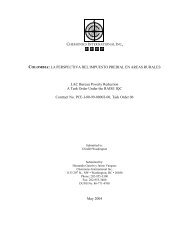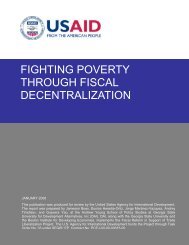Effectiveness and Economic Impact of Tax Incentives in the SADC ...
Effectiveness and Economic Impact of Tax Incentives in the SADC ...
Effectiveness and Economic Impact of Tax Incentives in the SADC ...
You also want an ePaper? Increase the reach of your titles
YUMPU automatically turns print PDFs into web optimized ePapers that Google loves.
ECONOMIC TOOLKIT 4-3<br />
is also zero. With a well designed program <strong>the</strong> same <strong>in</strong>centive could be obta<strong>in</strong>ed without<br />
forego<strong>in</strong>g all <strong>of</strong> <strong>the</strong> company tax revenue.<br />
If we modify <strong>the</strong> example to <strong>in</strong>clude debt f<strong>in</strong>anc<strong>in</strong>g <strong>and</strong> deductibility <strong>of</strong> nom<strong>in</strong>al <strong>in</strong>terest<br />
expenses along with 100 percent expens<strong>in</strong>g <strong>of</strong> <strong>the</strong> capital outlay, <strong>the</strong>n <strong>the</strong> METR becomes<br />
negative. This is because <strong>the</strong> tax system reduces <strong>the</strong> real <strong>in</strong>terest rate through <strong>in</strong>terest<br />
deductions, effectively subsidiz<strong>in</strong>g debt f<strong>in</strong>anc<strong>in</strong>g, <strong>and</strong> <strong>the</strong> project as a whole.<br />
The tax wedge appears at two levels—one aris<strong>in</strong>g from taxes on <strong>the</strong> company, <strong>and</strong> a second<br />
stemm<strong>in</strong>g from taxes on <strong>the</strong> remittance <strong>of</strong> earn<strong>in</strong>gs or capital ga<strong>in</strong>s to <strong>the</strong> owners. Thus, <strong>the</strong><br />
METR can be computed <strong>in</strong> terms <strong>of</strong> <strong>the</strong> returns seen by <strong>the</strong> company undertak<strong>in</strong>g <strong>the</strong><br />
<strong>in</strong>vestment, or <strong>the</strong> owners <strong>of</strong> <strong>the</strong> company. The second approach gives a better <strong>in</strong>dicator <strong>of</strong><br />
<strong>the</strong> impact <strong>of</strong> <strong>the</strong> tax system on <strong>in</strong>vestment decisions. But <strong>the</strong> METR computation becomes<br />
more complicated, particularly if <strong>the</strong> <strong>in</strong>vestor is a foreign entity because <strong>the</strong> analysis must<br />
<strong>the</strong>n take <strong>in</strong>to account a variety <strong>of</strong> <strong>in</strong>teractions between host- <strong>and</strong> home-country tax laws. 47<br />
Most empirical studies estimat<strong>in</strong>g <strong>the</strong> METR from microeconomic data rely on <strong>the</strong> familiar<br />
proposition that pr<strong>of</strong>it-maximiz<strong>in</strong>g firms <strong>in</strong>crease <strong>in</strong>vestment to <strong>the</strong> po<strong>in</strong>t where <strong>the</strong> after-tax<br />
rate <strong>of</strong> return on capital equals <strong>the</strong> user cost <strong>of</strong> capital: RORat = UCC. By calculat<strong>in</strong>g <strong>the</strong> UCC<br />
with <strong>and</strong> without tax adjustments (as def<strong>in</strong>ed <strong>in</strong> chapter 2) one obta<strong>in</strong>s an <strong>in</strong>direct estimate <strong>of</strong><br />
<strong>the</strong> before- <strong>and</strong> after-tax rates <strong>of</strong> return on capital.<br />
A strik<strong>in</strong>g result <strong>of</strong> such studies is that <strong>the</strong> METR can differ greatly from sector to sector, even<br />
if all <strong>in</strong>vestors face <strong>the</strong> same tax regime, with no special tax preferences. The METR<br />
differences reflect <strong>in</strong>herent biases <strong>in</strong> <strong>the</strong> basic tax code, as a function <strong>of</strong> <strong>the</strong> capital structure<br />
(mach<strong>in</strong>ery, plant, vehicles, l<strong>and</strong>) <strong>and</strong> f<strong>in</strong>ancial structure (debt versus equity), among o<strong>the</strong>r<br />
th<strong>in</strong>gs. For example, <strong>the</strong> World Bank (1988, 92) reports on a study <strong>in</strong> Malawi which showed<br />
that <strong>the</strong> METR <strong>in</strong> 1984 varied from 47 percent to 67 percent despite a uniform statutory tax<br />
rate <strong>of</strong> 50 percent. The variations depended on whe<strong>the</strong>r an <strong>in</strong>vestment was <strong>in</strong> manufactur<strong>in</strong>g<br />
or not, <strong>and</strong> whe<strong>the</strong>r <strong>the</strong> capital assets were short- or long-lived. Similarly, Chua (1995) cites a<br />
Canadian study which found that <strong>the</strong> METR for <strong>in</strong>vestment <strong>in</strong> mach<strong>in</strong>ery <strong>in</strong> <strong>the</strong> mid-1980s<br />
ranged from 0.4 percent <strong>in</strong> agriculture <strong>and</strong> 7.6 percent <strong>in</strong> manufactur<strong>in</strong>g to 31.6 percent <strong>in</strong><br />
utilities. A study by Broadway et al. (1995) found that METRs <strong>in</strong> Malaysia <strong>in</strong> 1993 varied by<br />
more than ten percentage po<strong>in</strong>ts depend<strong>in</strong>g on <strong>the</strong> sector <strong>of</strong> activity <strong>and</strong> whe<strong>the</strong>r <strong>the</strong> projects<br />
were f<strong>in</strong>anced by bonds or reta<strong>in</strong>ed earn<strong>in</strong>gs. These figures show that tax policy imposes a<br />
strong bias on <strong>in</strong>vestment patterns even <strong>in</strong> <strong>the</strong> absence <strong>of</strong> selective tax breaks.<br />
47 There are many variations to take <strong>in</strong>to account, <strong>in</strong>clud<strong>in</strong>g home country provisions for tax paid <strong>in</strong> overseas<br />
operations, <strong>the</strong> presence <strong>of</strong> double tax agreements <strong>and</strong> tax spar<strong>in</strong>g agreements, company options for<br />
deferr<strong>in</strong>g repatriation <strong>of</strong> earn<strong>in</strong>gs, <strong>and</strong> whe<strong>the</strong>r <strong>the</strong> company has an excess or deficit <strong>of</strong> foreign tax credits on<br />
a worldwide basis. These complications go beyond <strong>the</strong> scope <strong>of</strong> <strong>the</strong> present study. See OECD (2001) <strong>and</strong><br />
Slemrod (1995) for more details.


